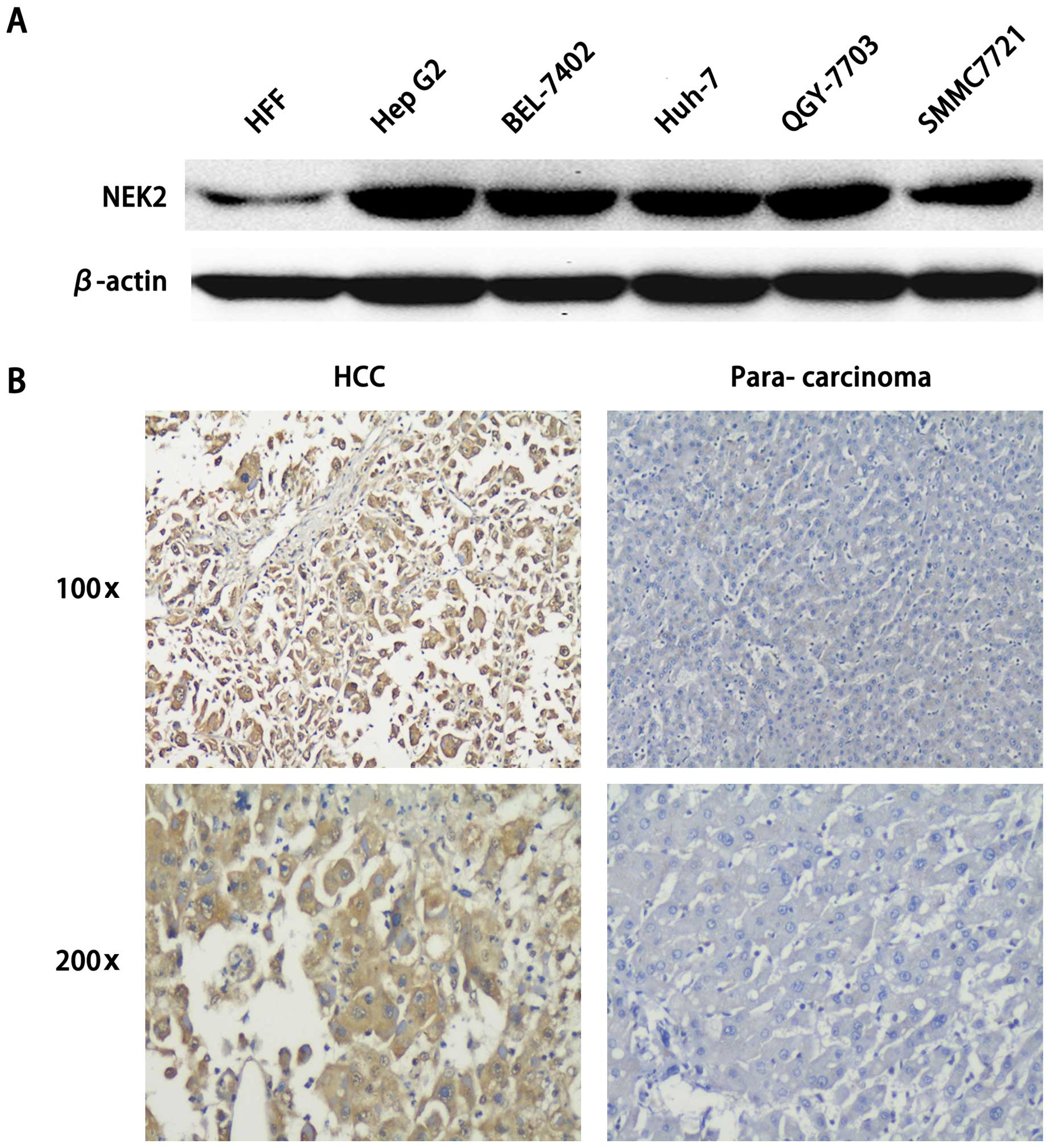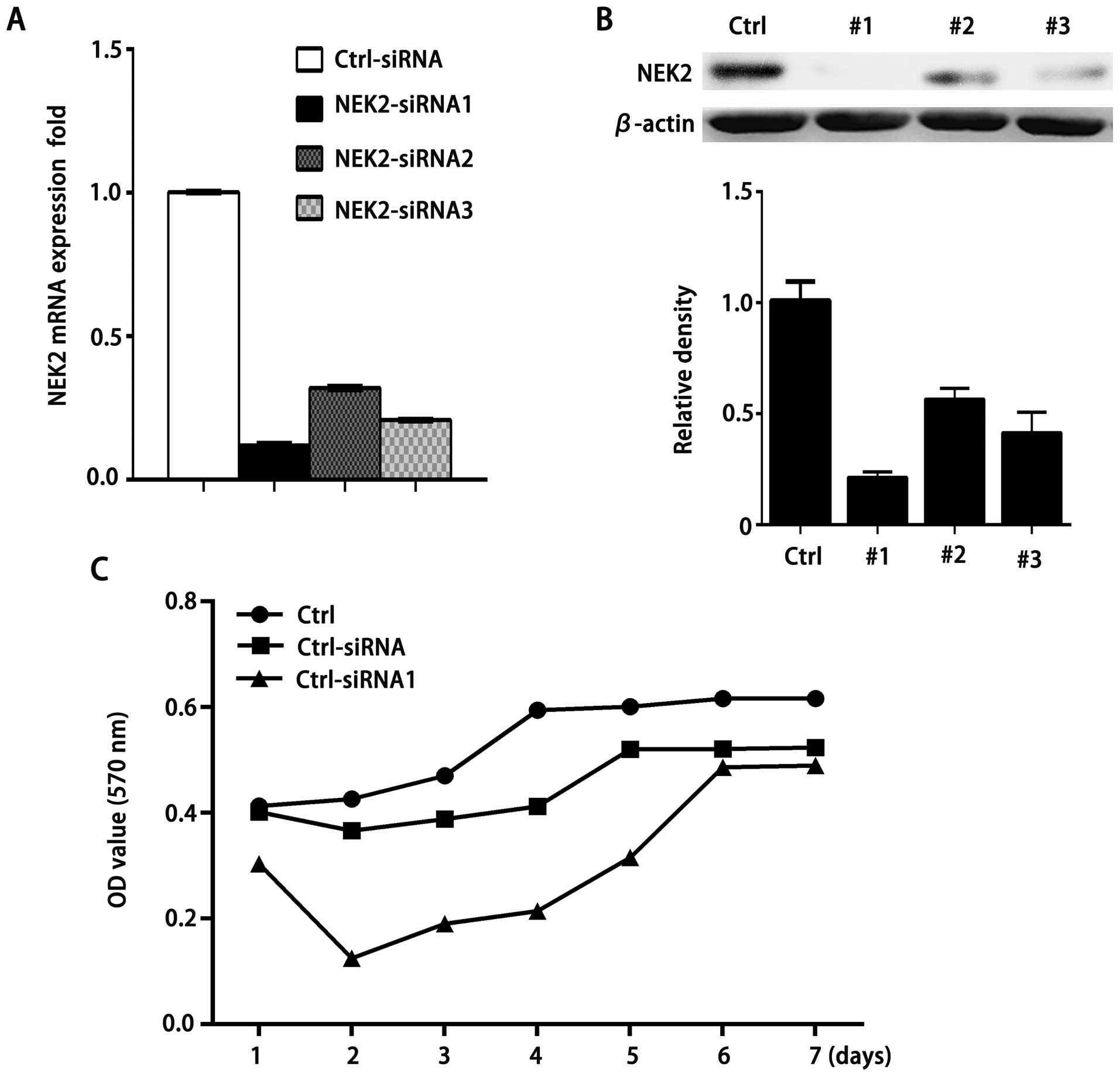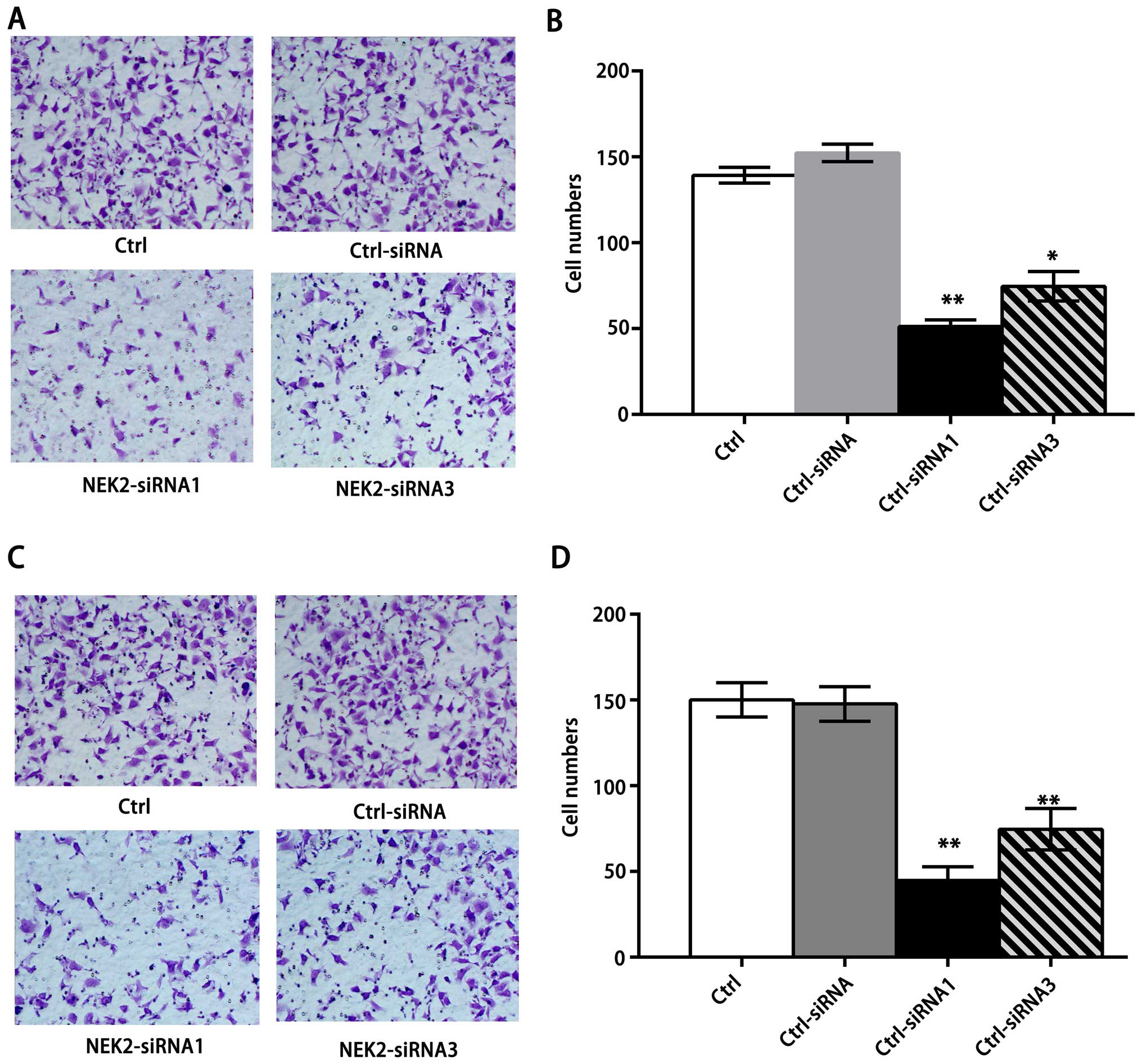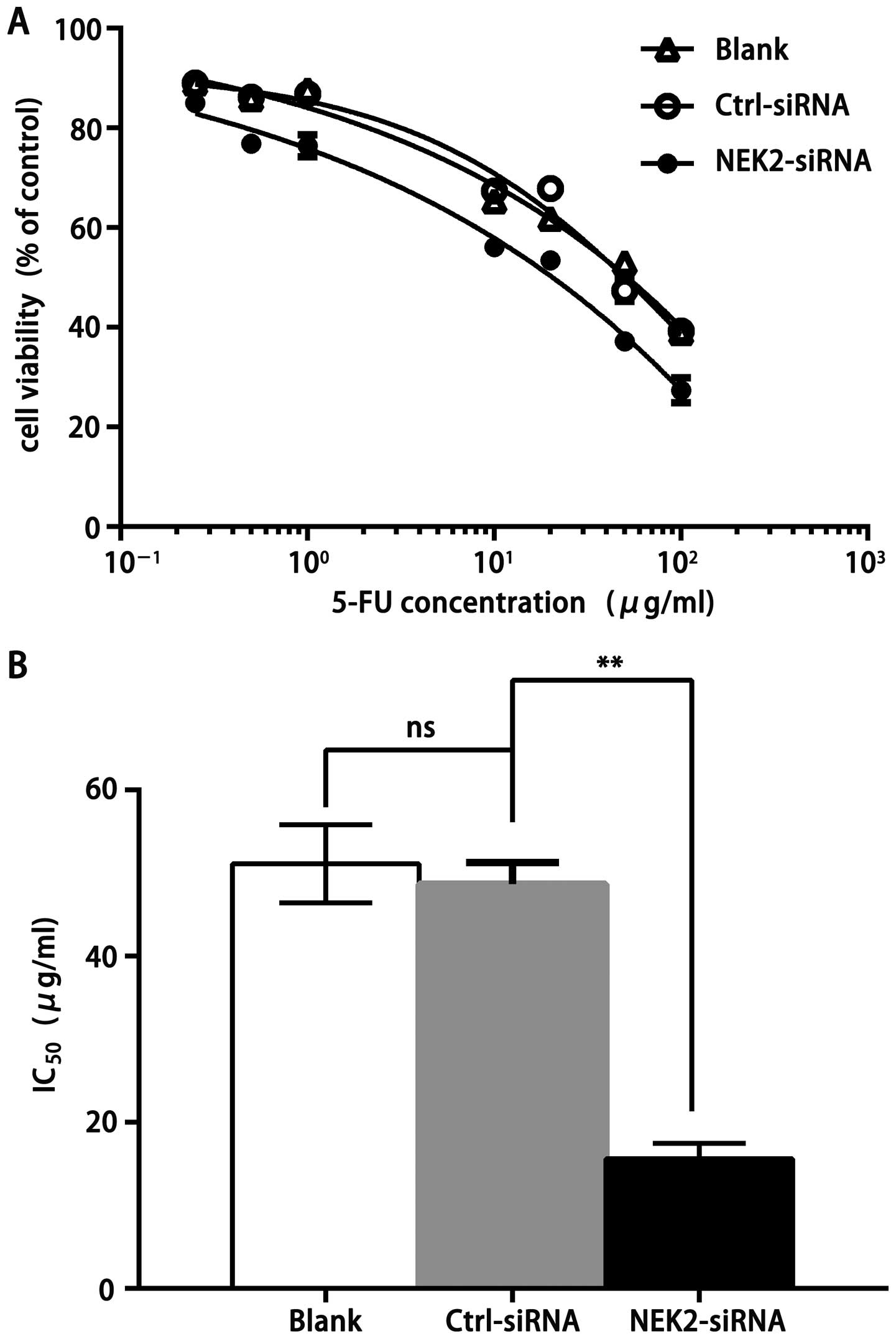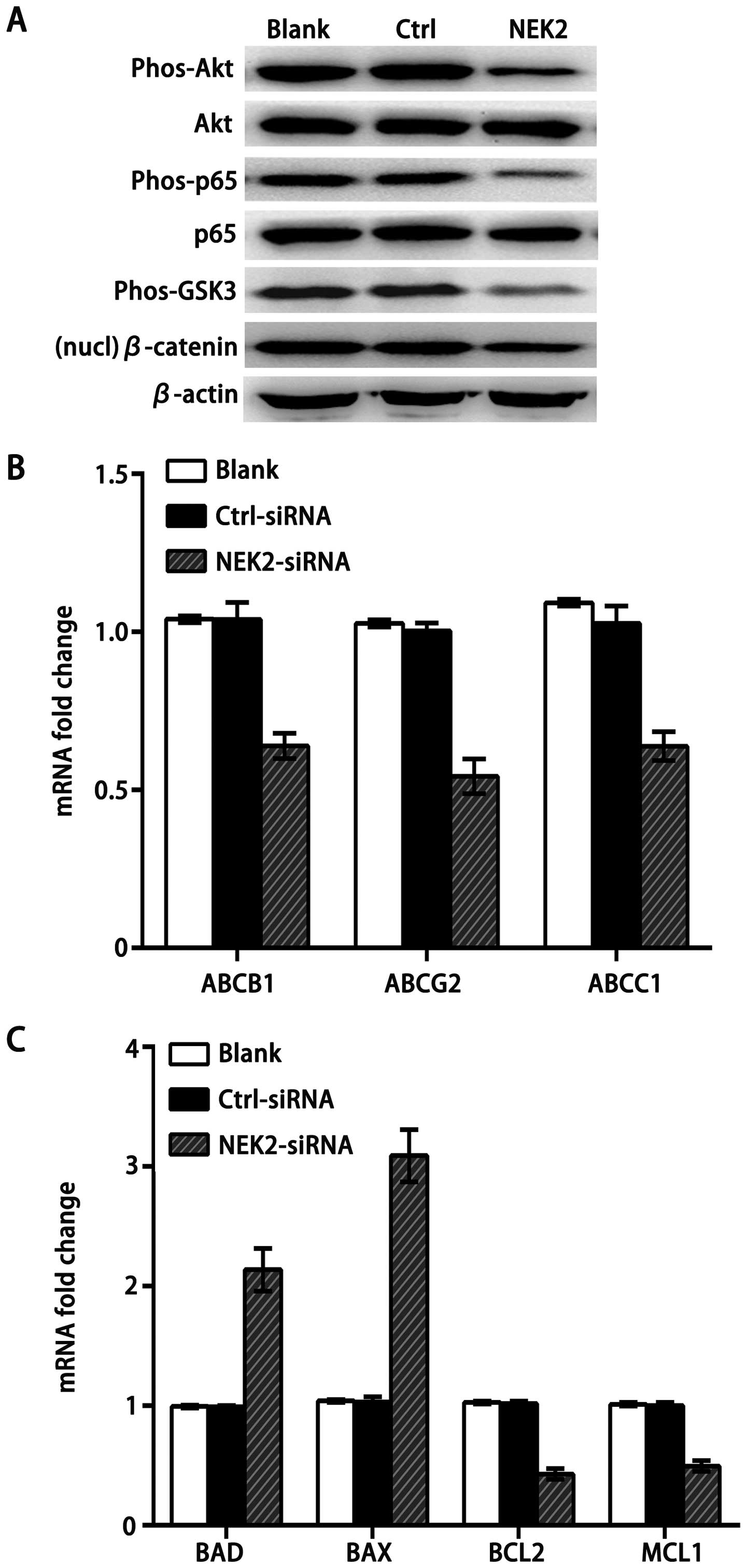Increased NEK2 in hepatocellular carcinoma promotes cancer progression and drug resistance by promoting PP1/Akt and Wnt activation
- Authors:
- Published online on: August 9, 2016 https://doi.org/10.3892/or.2016.5009
- Pages: 2193-2199
Abstract
Introduction
Hepatocellular carcinoma (HCC) is a highly aggressive and heterogeneous disease, and is among the leading causes of cancer-related deaths, especially in China (1). Although clinical treatments of HCC have been developed, uncontrolled metastasis and high recurrence lead to poor prognosis of HCC patients. A major reason for HCC-treatment failure is the existence of a drug-resistant subclone, either presenting at diagnosis or development during treatment. Therefore, it is urgent to achieve new treatment options for HCC and explore the molecular mechanisms underlying carcinogenesis and progression of HCC.
NIMA-related expressed kinase 2 (NEK2) as one of chromosomal instability (CIN) genes, is a member of the serine-threonine kinase family NEK, and functional studies have implicated that NEK2 is involved in cell division and mitotic regulation by centrosome splitting (2,3). Increased expression of NEK2 has been reported in certain cancers, such as breast, cervical, prostate carcinomas, lung cancer, and lymphoma, suggesting the involvement of NEK2 in cancer development (4–8). Additionally, NEK2 has been proven to play pivotal roles in cell proliferation and drug resistance of cancer cells with poor prognosis in myeloma, in which both protein phosphatase 1 (PP1)/Akt and Wnt pathways are involved (9). According to the current network-based interpretation of transcript expression level, NEK2 was significantly elevated in HCC patients compared to normal controls (10). However, despite these studies, the roles of NEK2 in HCC carcinogenesis and progression, especially for drug resistance still remain unknown.
In this study, we investigated the role of NEK2 in HCC development. We found that NEK2 is significantly increased in both HCC tissues and cell lines, and participates in HCC progression and drug resistance. Mechanistically, PP1/Akt and Wnt signaling activation are significantly inhibited by NEK2 knockdown, which implicates the role of NEK2 in promoting HCC progression. Collectively, our data show that enhanced NEK2 expression promotes HCC progression and drug resistance by promoting PP1/Akt and Wnt pathway activation, which may represent a new therapeutic target for HCC.
Materials and methods
Clinical samples
There were 64 patients who underwent resection for HCC between 2011 and 2012 at the Department of Hepatobiliary Surgery, the Second Xiangya Hospital of Central South University. None of these patients received chemotherapy or radiotherapy before the operation. The group was composed of 52 men and 12 women at the time of operation. A summary of patient characteristics and pathological features is presented in Table I. Tumor specimens were either cut immediately after removal from the resected hepatic tissues, frozen in liquid nitrogen, and then stored at −80°C or collected in 10% formalin and then embedded in paraffin for histopathological analysis.
Antibodies, reagents and RNA interference
Phos-Akt (Ser473), Akt (C67E7) rabbit nuclear factor-κB (NF-κB) p65 (D14E12), phos-NF-κB p65 (Ser536), phos-GSK3 (Ser9), β-catenin (D10A8) and β-actin (8H10D10) used for immunoprecipitation were from Cell Signaling Technology, Inc. Antibodies to NEK2 (ab55550) for western blotting and immunocytochemistry were from Abcam (Cambridge, MA, USA). All antibodies were used according to the manufacturer's instructions. 5-Fluorouracil (5-FU) was purchased from Shanghai Xudong Haipu Pharmaceutical Co., Ltd. (Shanghai, China) and was diluted directly with cell culture medium to the desired concentration. Transient transfection of plasmid DNA was performed using Lipofectamine Plus reagent (Invitrogen) according to the manufacturer's instructions. For RNA interference, siRNAs specific to NEK2, siRNA1 (5′-CAU UUG UUG GCA CAC CUU AUU-3′), siRNA2 (5′-GCU GAG AAA CAG AUG CUU GUU-3′) and siRNA3 (5′-UCU GUU GAA GAA CUA CAG CUU-3′) were purchased from GenePharma Co., Ltd., and transfected into the cells using Lipofectamine RNAi MAX (Invitrogen) according to the manufacturer's instructions. Non-specific control siRNA (5′-AAG TAG CCG AGCT TCG ATT GC-3′) was also used.
Cell culture
HepG2, BEL-7402, QGY-7703, SMMC7721 and Huh-7 were from the Institute of Biochemistry and Cell Biology (Shanghai Institutes for Biological Sciences, CAS). Cells were cultured in RPMI-1640 (Gibco, 31800022; 1.5 g/l NaHCO3, 2.5g/l glucose, 0.11g/l sodium pyruvate) supplemented with 10% fetal calf serum (FCS; Invitrogen) in a humidified incubator under 5% CO2 at 37°C.
Cell proliferation and half maximal inhibitory concentration (IC50) values
Cell proliferation was determined using MTT assay of cell proliferation as described before (11). Cells were cultured into a 96-well plate at 1×104 cells/well (n=4 for each time point) in a final volume of 100 µl. Cells were cultured for 36–48 h after transfection with NEK2-siRNA and ctrl-siRNA (non-specific control siRNA), respectively. Then, 20 µl MTT (5 mg/ml) was added to each well (0.8 mg/ml final concentration) for further incubation for 4 h. Then the medium was removed, and 100 µl DMSO was added to dissolve the solid formazan for 15 min. The absorbance of each well was read at 490 nm using a microplate reader (Thermo Fisher Scientific, Inc.). For drug resistance assay, cells were stimulated with different concentrations (0, 0.25, 0.5, 1, 20, 50 and 100 µg/ml) of 5-FU in culture medium for 48 h after transfection with siRNA. The IC50 values were calculated by non-linear regression analysis using SPSS 17.0 software (SPSS, Chicago, IL, USA) as describe before (12).
In vitro cell-invasion and -migration assays
Migration and invasion assay Transwell filters coated with collagen I or Matrigel (8-mm pore size; BD Biosciences) were used for migration or invasion assays, respectively. Cells (1.5×104) were seeded into the upper chamber in RPMI-1640 with 0.5% fetal bovine serum (FBS). The bottom chamber contained RPMI-1640 with 10% FBS. Cells were allowed to migrate/invade at 37°C in 5% CO2 for 24 h before they were fixed with methanol/methylene blue solution, stained with crystal violet (Beyotime, Shanghai, China), imaged, and counted with a microscope (Leica, UK). All experiments were performed in triplicate. Cell counts were performed on 10 fields per filter, and the mean was normalized to the migration/invasion cell count of control cells.
Quantitative real-time PCR
Total RNA was extracted with TRIzol reagent (Invitrogen) following the manufacturer's instructions. Real-time quantitative RT-PCR analysis was performed using the LightCycler (Roche Diagnostics) and SYBR RT-PCR kits (Takara Biotechnology Co., Ltd.). For mRNAs analysis, the primers were: human NEK2 forward, 5′-CCG CCC AAG TCA CAG CAG CAGA-3′ and reverse, 5′-GGG AGA AGA GCA GCA GCA GGA AGC-3′; human β-actin forward, 5′-CAT CCT GCG TCT GGA CCT GG-3′ and reverse, 5′-TAA TGT CAC GCA CGA TTT CC-3′; human ABCB1 forward, 5′-AGG CTC GCC AAT GAT GC-3′ and reverse, 5′-TCC TGT CCC AAG ATT TGC TAT-3′; human ABCG2 forward, 5′-TGA AAC CTG GTC TCA ACGC-3′ and reverse, 5′-AGA GTG CCC ATC ACA ACA TC-3′; human ABCC1 forward, 5′-CGC CTT CGC TGA GTT CCT GC-3′ and reverse, 5′-AGT TCT GCG GTG CTG TTG TGG-3′. The relative expression level of mRNAs was normalized to that of internal control GAPDH by using 2−ΔΔCt cycle threshold method (13).
Cell extraction, protein electrophoresis, and western blotting
Whole cell lysates of QGY-7703 cells were prepared in radioimmunoprecipitation assay buffer [50 mmol Tris-HCl (pH 8.0), 150 mmol NaCl, 1% NP40, 0.5% sodium deoxycholate, and 0.1% SDS]. Briefly, cells were washed in ice-cold 1X PBS (pH 7.4) and lysed directly in radioimmunoprecipitation assay buffer on ice for 30 min, centrifuged at 4°C, 14,000 rpm, to remove insoluble material and total protein concentration of the resulting supernatant determined by bicinchoninic acid assay (Pierce Biotechnology, Inc., Rockford, IL, USA). Lysate, 50 µg, for each cell line was resolved by sodium dodecylsulfate-polyacrylamide gel electrophoresis (SDS-PAGE), For immunoblot analysis, protein samples were subjected to SDS-PAGE and transferred onto a nitrocellulose membrane. The membrane was incubated with a primary antibody overnight at 4°C after blocking with 5% skim milk in 0.1% TBST (Tris-buffered saline with 0.1% Triton X-100) for 60 min. The second day, the membrane was incubated with a horseradish peroxidase-conjugated secondary antibody for 60 min after washing three times with 0.1% TBST, then, the membrane was incubated with the ECL solution after washing three times with 0.1% TBST, and exposed to X-ray film.
Immunocytochemistry and image processing
Immunohistochemical studies on NEK2 were performed on formalin-fixed, paraffin-embedded tissue sections obtained from the aforementioned patients with HCC. Tissue sections were deparaffinized and then boiled in 0.01 mol/l sodium citrate buffer (pH 6.0) in a 1,000 W microwave oven for 10 min to retrieve cell antigens. The primary antibody used was rabbit polyclonal NEK2 antibody (1:200 dilution; Bioss, China). All tissue sections were immunohistochemically stained using the avidin-biotin-peroxidase method and were counterstained with hematoxylin. The staining was scored by three independent investigators without knowledge of patient outcomes. The sections were evaluated at low magnification (×100 or ×200) to identify areas where NEK2 was evenly stained.
Statistical analysis
The data were subjected to statistical analysis using the SPSS software package (version 17.0). The clinicopathological parameters were tested by χ2 test and bivariate analysis (14). All data are presented as the mean ± SD. The statistical differences were analyzed by Student's t-test and repeated measures of ANOVA. The differences were considered to be statistically significant at P<0.05.
Results
NEK2 expression is significantly elevated in HCC
NEK2 is considered an oncogene and is overexpressed in various tumors (8,15,16). In order to examine the roles of NEK2 in HCC development, we examined the expression of NEK2 in HCC tissues and cell lines. As shown in Fig. 1A, compared with negative control HFF (human fibroblast cell line), in HCC cell lines HepG2, BEL-7402, QGY-7703, SMMC7721 and Huh-7, we found that NEK2 was highly expressed. Furthermore, NEK2 expression was significantly increased in HCC tissues as compared to that in the matched non-tumor tissues. Hence, these data confirm that NEK2 expression is significantly increased in both HCC tissues and cell lines, which indicates an important role in HCC carcinogenesis and progression.
We further examined the correlation between NEK2 and the clinicopathological characteristics of patients with HCC. As summarized in Table I, NEK2 expression was not significantly correlated with age or histological grades. However, NEK2 expression was significantly correlated with tumor size, differentiation grading and lymph node metastasis (P=0.001, 0.045 and 0.029). Together, these data suggest that elevated NEK2 expression in HCC is correlated with the clinical progression of HCC patients.
NEK2 promotes proliferation of HCC cells
As NEK2 expression is increased in HCC, we next investigated the roles of NEK2 increase in HCC development. RNA interference has emerged as natural and highly efficient mechanism for gene silencing (17–19). In order to test the functional role of NEK2 on cell growth, we have designed three siRNA candidates based on NEK2 gene sequence. Real-time PCR confirmed a remarkable downregulation of NEK2 expression in QGY-7703 cells after transfection of these NEK2-siRNAs (Fig. 2A). Additionally, relative amounts of NEK2 protein were decreased by siRNA1, 2 and 3 respectively, compared with those of control siRNA-treated cells (Fig. 2B). In contrast, transfection with control siRNA did not alter NEK2 expression significantly.
We then examined the effect of NEK2 knockdown on cell growth of QGY-7703 cells. As shown in Fig. 2C, the growth of QGY-7703 cells was substantially suppressed by treatment with NEK2 siRNA1 or 3 compared with control siRNA-treated cells. The results indicate that NEK2 can promote HCC cell proliferation.
NEK2 promotes migratory and invasive capacities of HCC cells
Because NEK2 controls microtubule organization, overexpressed NEK2 might affect tumor invasion and migration. Therefore, we studied the effect of NEK2 siRNA administration on the invasion and migration of HCC cells. Compared with their control cells and control siRNA-treated cells, knockdown of NEK2 markedly reduced the invasion of QGY-7703 cells (Fig. 3A and B), and also showed significantly impaired migration of QGY-7703 cells (Fig. 3C and D), suggesting that knockdown of NEK2 may dampen the microtubule organization to inhibit their mobility potential. Together with the role of NEK2 in the promotion of HCC proliferation, we conclude that NEK2 promotes HCC progression.
NEK2 knockdown frustrates drug resistance of HCC cells
We subsequently tested if knockdown of NEK2 expression could decrease drug resistance to fluorouracil injection (5-FU) using insensitive SMMC7721 cell lines. 5-FU inhibited cell proliferation of the SMMC7721 cell lines in a dose-dependent manner (Fig. 4A). Results of IC50 from the representative SMMC7721 were 51.1±4.70, 48.69±2.57 and 15.61±1.85 µg/ml in SMMC7721 cells non-treated, treated with ctrl-siRNA or NEK2-siRNA, respectively (Fig. 4B). SMMC7721 cells with NEK2 knockdown showed a significant decrease of IC50, indicating that highly elevated NEK2 could promote drug resistance to 5-FU.
NEK2 activates both Akt and canonical Wnt signaling
NEK2 is known to regulate the mitotic centrosome separation through reversible phosphorylation of its substrates PP1 (20) and β-catenin (21) in yeast, which is also important for cancer cell drug resistance and proliferation (9). Another study demonstrated that the transcriptional level of NEK2 is increased in many aggressive types of cancer, and at least two pathways, PP1/Akt and Wnt signaling, are involved in NEK2-induced cancer cell progression and drug resistance. Consistently, knockdown of NEK2 by siRNA impaired the phosphorylation of Akt, glycogen synthase kinase-3 (GSK3), NF-κB and decreased nuclear β-catenin (Fig. 5A), which activates drug resistance and pro-survival gene members. Furthermore, we found that knockdown of NEK2 downregulated mitotic checkpoint protein ABC transporter family members, including ABCB1, the drug resistance protein ABCC1 (MRP1), and the breast cancer resistant protein ABCG2 (BCRP) (Fig. 5B). In addition, knockdown of NEK2 decreased the expression of pro-survival gene members of the BCL2 family (BCL2 and MCL1) in SMMC7721 cell lines, while promoted the pro-apoptotic gene members BAD and BAX, which are suppressed by Akt (Fig. 5C). These results strongly suggest that PP1 and β-catenin are the downstream targets of NEK2 in HCC cells, and increased NEK2 could contribute to HCC progression by amplifying the PP1/Akt and Wnt pathway.
Discussion
HCC is the third most common cause of cancer-related deaths worldwide (22,23). NEK2, a member of the NIMA-related family, has several putative roles in cell differentiation, proliferation by centrosome splitting (3,24). Overexpression of active NEK2 leads to CIN, cell proliferation and drug resistance, which are also commonly observed in cancers including virtually all myelomas (9,25). Our study showed that centrosomal kinase NEK2 expression was significantly upregulated in HCC cell lines and tissues (Fig. 1). According to Table I, NEK2 expression is correlated with tumor size, differentiation grading and lymph node metastasis, which suggests that NEK2 participates in the clinical progression of HCC patients. Our data also shown that NEK2 is mostly positive in the cytoplasm of the HCC tissue cells and promotes HCC progression and drug resistance by amplifying the PP1/Akt and Wnt signaling pathway.
In this study, we found that two pathways, PP1/Akt and Wnt signaling, are involved in NEK2-induced cancer cell progression. It has been revealed that PP1 regulates the Akt signaling pathway to control cell survival, invasion and migration (26,27). Akt functions through IKK to promote the transactivation potential and phosphorylation of NF-κB (28), which activates transcription of pro-survival gene members of the BCL2 family. In the cytoplasm, GSK3 form a β-catenin destruction complex which mediates the degradation of β-catenin, which is important for constitutive activation of the canonical Wnt signaling pathway and drives cell proliferation by direct induction of cell cycle regulators (29,30). Our findings support that NEK2 promotes the expression of phosphorylated Akt, GSK3, NF-κB and increases nuclear accumulation of β-catenin. Furthermore, we found that knockdown of NEK2 decreased the expression of ABC transporters, resulting in inhibited drug resistance of HCC cells. Additionally, drug resistance is a universal problem with current cancer therapies. CIN genes have also been associated with acquired or intrinsic drug resistance (31). We demonstrated that targeting NEK2 overcame drug resistance and cell growth of SMMC7721 cells to 5-FU.
In summary, elevated expression of NEK2 in HCC results in both impaired PP1/AKT and Wnt pathways, which are involved in NEK2-induced cancer cell drug resistance, invasion, migration and proliferation. Knockdown of NEK2 by siRNA inhibited QGY-7703 cell growth and decreased drug resistance in vitro. Thus, targeting CIN genes, such as NEK2, have the potential to translate into very important prognostic and therapeutic clinical tools. We are now exploring how NEK2 regulates its downstream targets and how interaction among those pathways is regulated by NEK2 in HCC.
Acknowledgments
This study was supported by the National Natural Science Foundation of China (81402001). We thank Professor Lifang Yang and Daiqiang Li for their excellent technical assistance.
References
|
El-Serag HB: Hepatocellular carcinoma. N Engl J Med. 365:1118–1127. 2011. View Article : Google Scholar : PubMed/NCBI | |
|
Fry AM: The Nek2 protein kinase: A novel regulator of centrosome structure. Oncogene. 21:6184–6194. 2002. View Article : Google Scholar : PubMed/NCBI | |
|
Fletcher L, Cerniglia GJ, Nigg EA, Yend TJ and Muschel RJ: Inhibition of centrosome separation after DNA damage: A role for Nek2. Radiat Res. 162:128–135. 2004. View Article : Google Scholar : PubMed/NCBI | |
|
Hayward DG, Clarke RB, Faragher AJ, Pillai MR, Hagan IM and Fry AM: The centrosomal kinase Nek2 displays elevated levels of protein expression in human breast cancer. Cancer Res. 64:7370–7376. 2004. View Article : Google Scholar : PubMed/NCBI | |
|
Tsunoda N, Kokuryo T, Oda K, Senga T, Yokoyama Y, Nagino M, Nimura Y and Hamaguchi M: Nek2 as a novel molecular target for the treatment of breast carcinoma. Cancer Sci. 100:111–116. 2009. View Article : Google Scholar | |
|
Cappello P, Blaser H, Gorrini C, Lin DC, Elia AJ, Wakeham A, Haider S, Boutros PC, Mason JM, Miller NA, et al: Role of Nek2 on centrosome duplication and aneuploidy in breast cancer cells. Oncogene. 33:2375–2384. 2014. View Article : Google Scholar | |
|
Liu X, Gao Y, Lu Y, Zhang J, Li L and Yin F: Upregulation of NEK2 is associated with drug resistance in ovarian cancer. Oncol Rep. 31:745–754. 2014. | |
|
Zhong X, Guan X, Dong Q, Yang S, Liu W and Zhang L: Examining Nek2 as a better proliferation marker in non-small cell lung cancer prognosis. Tumour Biol. 35:7155–7162. 2014. View Article : Google Scholar : PubMed/NCBI | |
|
Zhou W, Yang Y, Xia J, Wang H, Salama ME, Xiong W, Xu H, Shetty S, Chen T, Zeng Z, et al: NEK2 induces drug resistance mainly through activation of efflux drug pumps and is associated with poor prognosis in myeloma and other cancers. Cancer Cell. 23:48–62. 2013. View Article : Google Scholar : PubMed/NCBI | |
|
Drozdov I, Bornschein J, Wex T, Valeyev NV, Tsoka S and Malfertheiner P: Functional and topological properties in hepatocellular carcinoma transcriptome. PLoS One. 7:e355102012. View Article : Google Scholar : PubMed/NCBI | |
|
Min J, Li X, Huang K, Tang H, Ding X, Qi C, Qin X and Xu Z: Phloretin induces apoptosis of non-small cell lung carcinoma A549 cells via JNK1/2 and p38 MAPK pathways. Oncol Rep. 34:2871–2879. 2015.PubMed/NCBI | |
|
Deng L, Ren Z, Jia Q, Wu W, Shen H and Wang Y: Schedule- dependent antitumor effects of 5-fluorouracil combined with sorafenib in hepatocellular carcinoma. BMC Cancer. 13:3632013. View Article : Google Scholar | |
|
Livak KJ and Schmittgen TD: Analysis of relative gene expression data using real-time quantitative PCR and the 2(-Delta Delta C(T)) method. Methods. 25:402–408. 2001. View Article : Google Scholar | |
|
Herbst RS, Heymach JV and Lippman SM: Lung cancer. N Engl J Med. 359:1367–1380. 2008. View Article : Google Scholar : PubMed/NCBI | |
|
Neal CP, Fry AM, Moreman C, McGregor A, Garcea G, Berry DP and Manson MM: Overexpression of the Nek2 kinase in colorectal cancer correlates with beta-catenin relocalization and shortened cancer-specific survival. J Surg Oncol. 110:828–838. 2014. View Article : Google Scholar : PubMed/NCBI | |
|
Zhong X, Guan X, Liu W and Zhang L: Aberrant expression of NEK2 and its clinical significance in non-small cell lung cancer. Oncol Lett. 8:1470–1476. 2014.PubMed/NCBI | |
|
Jinek M and Doudna JA: A three-dimensional view of the molecular machinery of RNA interference. Nature. 457:405–412. 2009. View Article : Google Scholar : PubMed/NCBI | |
|
Moazed D: Small RNAs in transcriptional gene silencing and genome defence. Nature. 457:413–420. 2009. View Article : Google Scholar : PubMed/NCBI | |
|
Siomi H and Siomi MC: On the road to reading the RNA-interference code. Nature. 457:396–404. 2009. View Article : Google Scholar : PubMed/NCBI | |
|
Helps NR, Luo X, Barker HM and Cohen PT: NIMA-related kinase 2 (Nek2), a cell-cycle-regulated protein kinase localized to centrosomes, is complexed to protein phosphatase 1. Biochem J. 349:509–518. 2000. View Article : Google Scholar : PubMed/NCBI | |
|
Bahmanyar S, Kaplan DD, Deluca JG, Giddings TH Jr, O'Toole ET, Winey M, Salmon ED, Casey PJ, Nelson WJ and Barth AI: beta-Catenin is a Nek2 substrate involved in centrosome separation. Genes Dev. 22:91–105. 2008. View Article : Google Scholar : | |
|
Torre LA, Bray F, Siegel RL, Ferlay J, Lortet-Tieulent J and Jemal A: Global cancer statistics, 2012. CA Cancer J Clin. 65:87–108. 2015. View Article : Google Scholar : PubMed/NCBI | |
|
Jemal A, Bray F, Center MM, Ferlay J, Ward E and Forman D: Global cancer statistics. CA Cancer J Clin. 61:69–90. 2011. View Article : Google Scholar : PubMed/NCBI | |
|
Faragher AJ and Fry AM: Nek2A kinase stimulates centrosome disjunction and is required for formation of bipolar mitotic spindles. Mol Biol Cell. 14:2876–2889. 2003. View Article : Google Scholar : PubMed/NCBI | |
|
Hayward DG and Fry AM: Nek2 kinase in chromosome instability and cancer. Cancer Lett. 237:155–166. 2006. View Article : Google Scholar | |
|
Xiao L, Gong LL, Yuan D, Deng M, Zeng XM, Chen LL, Zhang L, Yan Q, Liu JP, Hu XH, et al: Protein phosphatase-1 regulates Akt1 signal transduction pathway to control gene expression, cell survival and differentiation. Cell Death Differ. 17:1448–1462. 2010. View Article : Google Scholar : PubMed/NCBI | |
|
Brunet A, Bonni A, Zigmond MJ, Lin MZ, Juo P, Hu LS, Anderson MJ, Arden KC, Blenis J and Greenberg ME: Akt promotes cell survival by phosphorylating and inhibiting a Forkhead transcription factor. Cell. 96:857–868. 1999. View Article : Google Scholar : PubMed/NCBI | |
|
Dan HC, Cooper MJ, Cogswell PC, Duncan JA, Ting JP and Baldwin AS: Akt-dependent regulation of NF-κB is controlled by mTOR and Raptor in association with IKK. Genes Dev. 22:1490–1500. 2008. View Article : Google Scholar : PubMed/NCBI | |
|
Fodde R and Tomlinson I: Nuclear beta-catenin expression and Wnt signalling: In defence of the dogma. J Pathol. 221:239–241. 2010. View Article : Google Scholar : PubMed/NCBI | |
|
Gehrke I, Gandhirajan RK and Kreuzer KA: Targeting the WNT/beta-catenin/TCF/LEF1 axis in solid and haematological cancers: Multiplicity of therapeutic options. Eur J Cancer. 45:2759–2767. 2009. View Article : Google Scholar : PubMed/NCBI | |
|
Kops GJ, Weaver BA and Cleveland DW: On the road to cancer: Aneuploidy and the mitotic checkpoint. Nat Rev Cancer. 5:773–785. 2005. View Article : Google Scholar : PubMed/NCBI |



